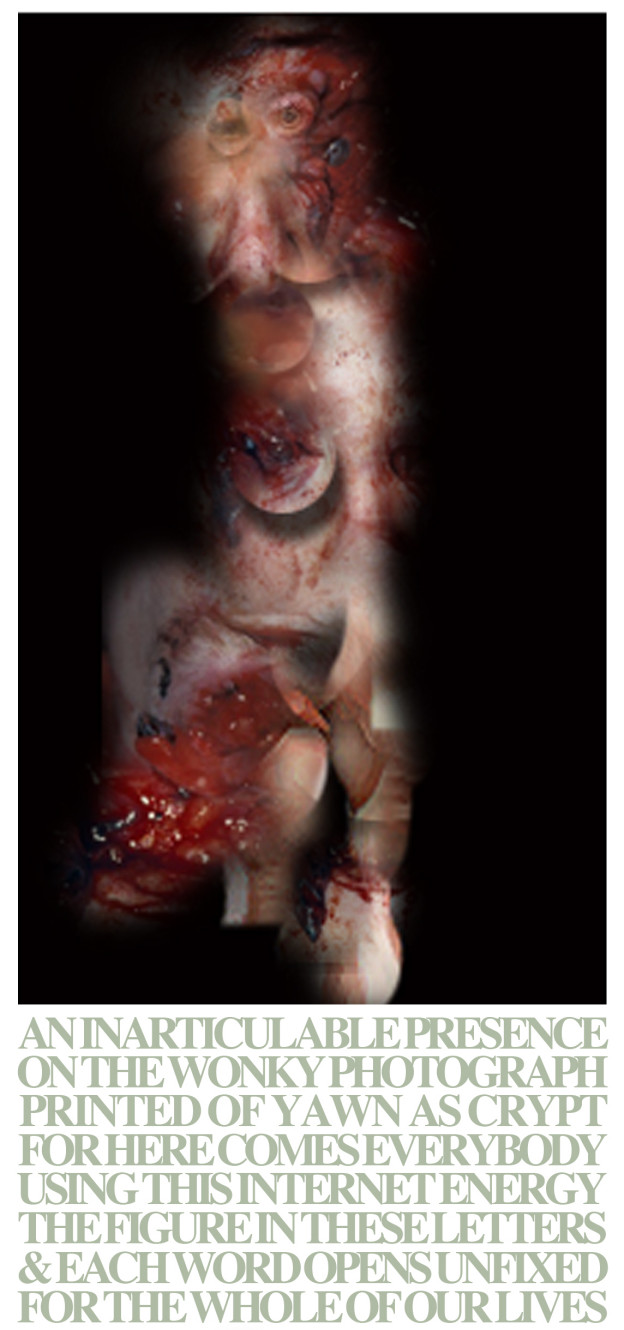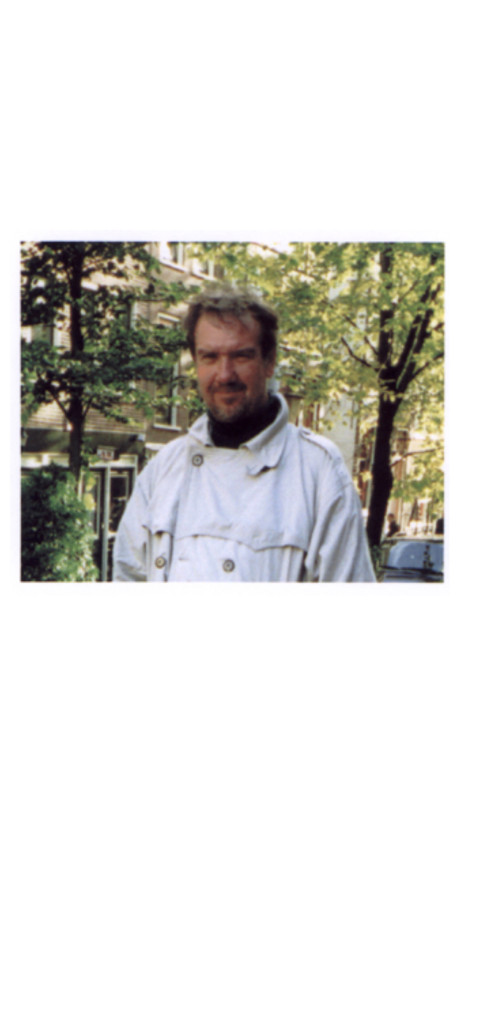There are two principal characters in Ann Hamilton’s texts on my work that up to now have probably been overlooked by her – “il” et “je” (he and I) elle et moi (she and I) representing a writer or narrator, often in the act of writing and/or reading the essays written by both, preparing to write it, or reflecting on or reacting to the action produced or not produced by “tu” (you) the reader. L’Attente, l’oubli (the waiting, oblivion) à la manière de Maurice Blanchot to the illustrated female en chacun de nous. Everyone serves as a type of background or distant audience in my work – all of course nameless – going about their lives indistinguishable and interchangeable as letters in an alphabet. What takes place in my work for the web – an art and writing that is literary, art historical, philosophical – is a kind of communion – (although an exhaustively commented one according to at least two of my acquaintances and one of my sons) – of different minds whose layers interrupt one another – endless minds. As Roland Barthes observed, a writer (art historian, artist) no matter how blatantly subversive his work, fulfills an essentially decorative and ornamental role in what has become at this moment a readerless rudimentary society of the electronic screen and beyond and within which “nous” (we) lack power that no longer passes by way of the consensual word, but prefers to inundate, intimidate, condition, and control by a vast panoply of subliminal strategies that render “notre” (our) agreement the merest formality. Terrorism by way of scholarship, reading, study and the empowerment of the intellect is the only kind of violence that is workable against such power. The result of thinking this phenomenon may divide the psyche as a form of dissociative identity disorder as is the case here – il, je, elle, moi, tu, nous, notre – transferring the will to power into the very electronic children from here to eternity whose futures will be as the countless victims of “progrès” (progress). The artist (author, painter, poet, musician, et al.) today is understood (if thought about at all in any significantly serious way) to be the quaint residue of what once was Situationist International activities “against” the society of the spectacle that has overtaken the lands of the world so obviously generated by and within the electronic screen – is it any wonder that revolutions in support of intellectual nous, intelligence and large breadths of reading are bound to be inevitably disappointed – not to mention permanently disavowed – by the followers of amateur art that was actually an Expressionist modern “movement” many moons ago in WWI Germany of which nobody nowadays would appear to know. None of this bodes well for the continued existence of irony and double-irony that will not so much have been forsaken as simply forgotten as a high-form of linguistic credit – diachrony yielding to synchrony whereby chronological and comprehensive visions and stories have become the accepted regulation. Amateur art splices the likes of Saatchi/Frieze and untaught “talent” in Here Comes Everybody who is statistically anybody – there is no good or bad here – simply vacuousness “vacuité” and fun? “fête foraine” in all of us – en chacun de nous – and yes, Joyce knew what he was doing when HCE became the sigla E for FinnEgans WakE and what could possibly make us think otherwise!
Imperative, as a reason for two separate essays from Ann and myself at this point of the work on Finnegans Wake as thought, are the demands posed by the critical concept of irony all the same. We should recall the complexity of the human mind in creating irony as a contingent or intervening force, as a mode establishing itself in the text to convey the unexpressed “ironical” meaning. Being modal it is a perceptive, neutral or functional power that has no substantive meaning. In overlooking the labyrinth of irony as a networking of puissance and potential there is a great danger of investing the current artistic abyss with the merit of Derrida’s effaced coin without being aware of the dire straights creativity has evolved for itself as a consequence of its intellectual, scholarly demise as a premise for brilliance, sophistication and deep perception. There is “hope” in irony in intervening to establish almost any variety or degree of meaning and, moreover, intervene in any of various ways, devices or uses. With the demise of creative thought-power in a world spaced out and flattened it will be for future generations to errect an effective active freedom around which they can build new varieties of “hope” unrestrained by a desire for singularity – 15 minutes of “fame” (already exessive) – the twinning of female/male in the artistic phsyche and the irony, as it would seem to be, of disinterest in any form of creative artistic judgement on anything that might be of more interest than a pixilated Monet waterlilly. The typical act of individuality in Finnegans Wake – a single subject – is a permeable and unstable entity liable to be “possessed” by other (momentarily) more insistent beings with more urgent incommunicable things to “communicate” – splitting personalities, or at least names and letters, becomes the one device by which the work in progress incompletes itself through Ann (ALP) Humphrey Chimpden Earwicker (HCE), Shem, Shaun and Issy – the unfullbodied family of Man.
Finnegans Wake as an artistic philosophical project for the visually interested within the internet artworld, allows time projected into space as an interpenetration of as many different events that are called art without imposing judgement even as a force of irony or taking offence at its own desocialising indifference. Everything is carried-out with a straight face and strong heart – if you like one might think of it as an unconvincing avatar of this and the next “performance” as antiliterature through detachment, as Joyce and others (Tzara, Leiris, Beckett, Sollers etc.) have understood it. Everything in this dual space is evanescent, transitory and transitional while male and female parts intertwine rather like Diderot’s observation on the paradox of the comedian defining a kind of altered state where the actor is best who acts the role that he does not feel. Typically thought is of course more complex than any of this, but only inasmuch as the notion of passion in the work of art underway is more subversive (or tries to be) than is usually thought to be the case for the individual.
Reading the Wake as a group as opposed to individual reading as such is a feature that has been around for many years hence the book’s likeness to Internet Interraction as one group in particular perhaps would assure us:
The Internet has made reading Joyce easier. The group first formed after Erik posted an announcement online. Joel uses the Web to find the primary texts that Joyce cites. “Sometimes I feel, when I look up a certain word, that I’m looking at the same source document that Joyce was looking at,” he says. A phrase on page 296—“And let you go, Airmienious, and mick your modest mock Pie out of humbles up your end”—led Joel to Google, where he discovered that the wordAirmienious ties together the page’s multiple references to Armenia and the Germanic general Arminius who defeated three Roman legions in 9 A.D. The Wake, in this sense, captured the dizzying amplitude of the Internet before it existed. Like the Web, the book is an incredibly vast, far-reaching, piecemeal collection that is brilliant and unifying when taken in context, but gibberish when not. (Also, a portion of each has been dedicated to naked women.) Almost every phrase in the book is a sort of hyperlink to a half-dozen other sources or ideas, and, in fact, a Wiki-Wake is in the works. Click on a word on page three and you’ll get a link to a half-dozen notes that people have posted explaining its significance. Click on something on page 555 and you’re still on your own. The Internet has not yet caught up with the Wake.


